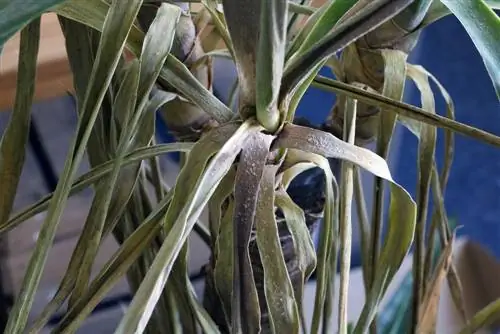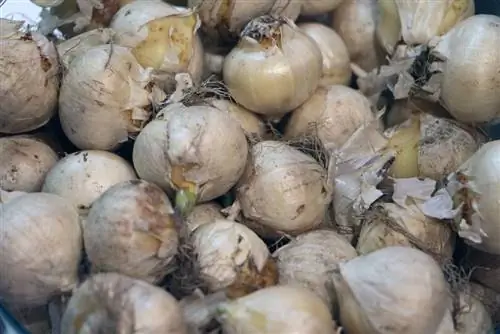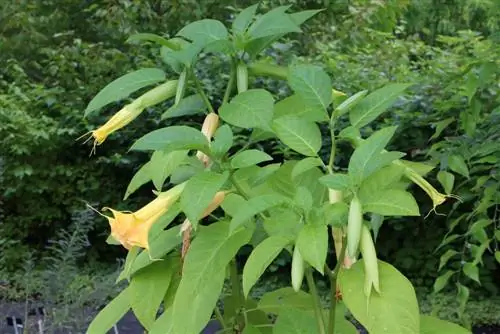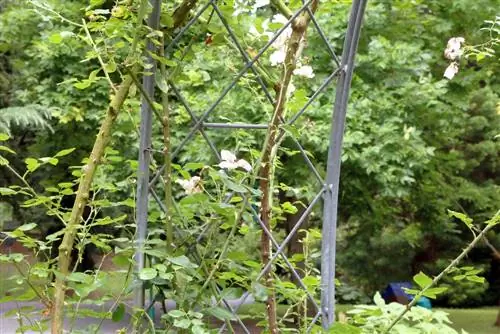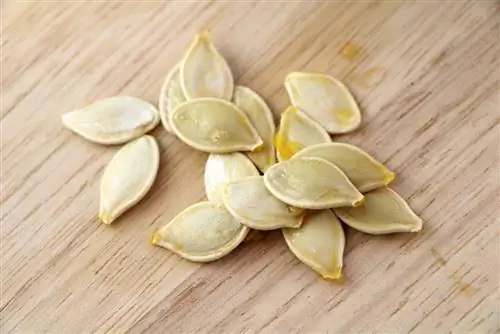- Author admin [email protected].
- Public 2023-12-17 03:39.
- Last modified 2025-01-24 12:45.
Even with good care and optimal site conditions, houseplants occasionally become ill. The main causes of disease include bacteria, fungi, animal pests and viruses. If only the leaves change color, this is usually an indication of an unsuitable location or errors in care. If detected early, the plant can often be saved if countermeasures are taken immediately. That's why it's extremely important to regularly check all houseplants for infestation.
Common plant diseases
Various plant diseases have become established in the local latitudes, which can sometimes be controlled better, sometimes worse. The earlier these are detected, the greater the chances of successful combat:
Leaf spot disease
Typical causes of leaf spot are care errors, including excessive spraying, permanently moist substrate, very high humidity, a location that is too cold and windy, irrigation water that is too cold and inadequate air circulation. The symptoms of the fungus, as the name suggests, are manifested by spots on the leaves. The colors of the spots vary from brown to black to yellow. Leaf spot disease can be combated as follows:
- cut off leaves affected by the fungi
- For extremely large leaves, cut affected areas out of the leaf
- thoroughly disinfect the scissors or knives with alcohol before each new cut
- In case of hardship, spray plants with fungicides
- Broad spectrum fungicides are ideal
Powdery mildew
Powdery mildew is a fungal disease and is often confused with downy mildew. With powdery mildew, the leaf surface is covered by a white and mealy coating. However, the stems and flowers can also be affected. The following procedure has proven effective for powdery mildew:
- Cut off affected leaves immediately
- Disinfect the cutting tool carefully with alcohol
- Additionally spray affected plants with fungicides
Gray horse
The gray mold covers leaves, stems or flowers with a gray and velvety coating. Houseplants with very soft leaves and shoots are particularly susceptible to this disease. Gray mold often forms on parts of plants that are already damaged or even dead. The following measures have proven effective for gray mold:
- Immediately cut off affected leaves, stems and flowers
- Disinfect the cutting tool thoroughly with alcohol
- spray affected plants with fungicides after pruning
Sootdew
Sooty mold forms on houseplants when they are attacked by plant pests that produce honeydew. Although this does not attack the plant leaves directly, it looks very unsightly. The fungus also clogs the plant pores and thereby impairs photosynthesis. The following control measures lead to success with soot mold:
- First fight the plant pest that causes honeydew.
- Collect and remove plant pests.
- Then carefully wash off the soot mold with a soft cloth and a weak soap solution.
Blacklegs
Blackleg is caused by various fungi. The affected shoots turn black and begin to rot from the base. Heavy watering and soil that is constantly too moist are the main causes; young plants in soil that is too loamy and compacted are particularly susceptible. The following procedure should be followed when dealing with blackleg:
- Affected damaged areas normally no longer recover
- If cuttings are infested, dig them up with a spoon and dispose of the surrounding soil
- To prevent this, dip the cut end of the cuttings in fungicide
Viral diseases
Viruses are microorganisms that penetrate plant cells and completely change the basic structure of the plant cell. There are no measures to help and no cure for viral diseases. Infected plants must be destroyed immediately. Symptoms include yellowish streaks and mosaic-like spots on the leaves. The leaves then deform completely, become severely crippled and then die.
Rotting of leaves & roots
If the leaves of the plant rot, you need to act quickly so that it can be saved. The reason for rotten leaves is usually bacteria or fungi. However, if root rot occurs, it is already too late; this plant disease cannot be combated, only prevented. The following aspects should be taken into account in the event of signs of rot:
- If the leaves are rotting, cut them off generously
- Always use a clean and sharp knife or other cutting device
- Disinfect the cutting tool with high-percentage alcohol after every cut
- thorough disinfection prevents further spread of rot
- Make an incision in he althy tissue to ensure all bacteria have been removed
- Excessive watering often leads to root rot
- Constant standing water in the planter is also harmful
- first signs of root rot are pale and slightly grayish leaves
- leaves are often shed in large quantities
- Potting soil develops an extremely unappetizing smell over time
- Plant wilts and goes limp, then dies
Quarantine
If a plant has been infected and the disease has been successfully detected, the affected houseplant must be quarantined immediately. Otherwise, transmission to neighboring plants can occur, as most plant diseases are extremely contagious:
- place infected plants in rooms without other plants
- pay attention to similarly good location conditions
- remove and destroy all affected plant parts
- Most diseases spread very quickly through direct contact and through the air
- keep a close eye on injured plants
- injured tissue provides easy access for bacteria, fungi and viruses
- Early detection is the first step in preventing spread
Prevention
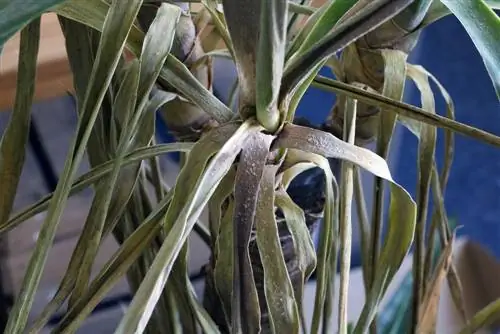
Prevention is always better than cure, this saying also applies to plant diseases. If the houseplant is he althy, well cared for and can grow in the best possible site conditions, it is not very susceptible to disease. However, if the plant is poorly cared for and often neglected, this weakens the immune system and pathogens have an easy time of it. The following aspects are crucial for prevention:
always pay attention to proper care
- Do not leave water on leaves and flowers
- maintain sufficient distance between individual plants
- Sufficiently large distances prevent the spread of diseases
- Use only high-quality and sterilized cultivation soil
- germ-free soil prevents diseases of the root system
Tip:
If you are unsure about the care measures, it is always better to find out more about the likes and dislikes of the respective plants in advance.
Conclusion
Plant diseases can usually be avoided if the care and cultivation conditions are right. However, if the plants grow poorly and the immune system is weakened, pathogens have a good chance of spreading quickly. It is important to constantly check all houseplants for unusual symptoms that deviate from the norm. In some cases, the affected specimen can still be saved if countermeasures are taken promptly. Quarantine of the affected plant is also crucial to avoid infections. However, if the disease is already advanced, it is always safer to dispose of the houseplant completely. Unfortunately, there are currently no useful tools to combat root rot and viral diseases.
What you need to know about houseplant diseases in brief
Discolored leaves
- Yellow leaves are often due to too much water, but can also be a sign of a location that is too dark or too cold.
- For most houseplants, the rule that only waters again when the top of the potting soil has become dry is helpful.
- The location should also be changed.
- Plants with brown leaves or dried tips, on the other hand, receive too little water.
- They usually appear on houseplants in the winter months, because then the air in heated rooms dries out slightly.
- In this case, it helps to spray the leaves every now and then or place a container with water near the plant.
Tip:
If all the conditions that a houseplant needs for he althy growth are met, the cause of discoloration of the leaves is usually a deficiency.
Potted plants cannot provide themselves with the necessary nutrients. You therefore need fertilizer regularly. These fertilizers are either added to the irrigation water in liquid form or inserted into the potting soil as sticks.
Root rot
- Excessive watering or water left in the planter can lead to root rot.
- The first symptoms of this are usually pale, slightly grayish leaves or a large number of leaves being dropped.
- It also happens that the potting soil develops an unpleasant smell.
- As it progresses, the plant becomes wilted and limp and eventually dies.
- Root rot is one of the diseases of houseplants that cannot be controlled.
Animal Pests
- Aphids are the main animal pests that attack houseplants. They can be controlled by spraying the leaves with a light dish soap solution.
- Fungus gnats are also relatively common. Yellow tablets, which are available in garden centers, are suitable for combating them. Because fungus gnats lay their eggs in the potting soil, it is also advisable to sprinkle some sand on the potting soil.
- Scale insects, thrips and spider mites can only live in dry air. If there is sufficient humidity, they usually disappear on their own. To speed up the process, they can also be carefully scraped off the leaves.
Worms in flower pots
- Worms in potting soil are usually not harmful to the plants, but they are not particularly aesthetic.
- They can be easily collected by dipping the pot ball of the plant in a container of water for a short time.
- This forces the worms to move to the surface of the water.
Common fungal diseases
- The leaf spot disease, in which the leaves develop different colored spots, is caused by a fungus.
- However, it only attacks the houseplants when they are already weakened.
- Better care appropriate to the species therefore helps to avoid this disease.
- If the plant is already infected, the discolored leaves should be removed to prevent the fungal spores from spreading further.
- Other diseases caused by fungi include powdery mildew, which appears as a white coating.
- Grey mold produces a gray coating. In this case too, it helps to remove the affected leaves and create better conditions.
- Severely infested plants, however, are best disposed of to protect other houseplants.
Final tip:
For all plant diseases caused by pests, fungi or bacteria, it is always advisable to isolate the affected plant. This way she doesn't infect the plants near her.

